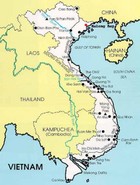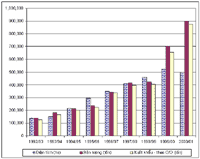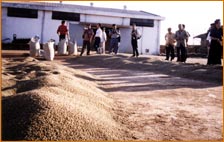Main menu:
Vietnam
Introduction |
|||||||||||||
Flag: |
|
||||||||||||
Card: |
|||||||||||||
Background: |
France occupied all of Vietnam by 1884. Independence was declared after World War II, but the French continued to rule until 1954 when they were defeated by communist forces under Ho Chi MINH, who took control of the north. US economic and military aid to South Vietnam grew through the 1960s in an attempt to bolster the government, but US armed forces were withdrawn following a cease-fire agreement in 1973. Two years later North Vietnamese forces overran the south. Economic reconstruction of the reunited country has proven difficult as aging Communist Party leaders have only grudgingly initiated reforms necessary for a free market. |
||||||||||||
Geography |
|||||||||||||
Location: |
Southeastern Asia, bordering the Gulf of Thailand, Gulf of Tonkin, and South China Sea, alongside China, Laos, and Cambodia |
||||||||||||
Coordinates: |
16° 00' N, 106° 00' E |
||||||||||||
Map references: |
SüdostasienSoutheast Asia |
||||||||||||
Area: |
total: 329,560 sq km |
||||||||||||
Land boundaries: |
total: 4,639 km |
||||||||||||
Coastline: |
3,444 km (excludes islands) |
||||||||||||
Maritime claims: |
contiguous zone: 24 NM |
||||||||||||
Climate: |
tropical in south; monsoonal in north with hot, rainy season (mid-May to mid-September) and warm, dry season (mid-October to mid-March) |
||||||||||||
Terrain: |
low, flat delta in south and north; central highlands; hilly, mountainous in far north and northwest |
||||||||||||
Elevation extremes: |
lowest point: South China Sea 0 m |
||||||||||||
People |
|||||||||||||
Bevölkerung: |
79.939.014 (July 2001 est.) |
||||||||||||
Nationality: |
noun: Vietnamese (singular and plural) |
||||||||||||
Ethnic groups: |
Vietnamese 85%-90%, Chinese, Hmong, Thai, Khmer, Cham, mountain groups |
||||||||||||
Religions: |
Buddhist, Hoa Hao, Cao Dai, Christian (predominantly Roman Catholic, some Protestant), indigenous beliefs, Muslim |
||||||||||||
Languages: |
Vietnamese (official), English (increasingly favored as a second language), some French, Chinese, and Khmer; mountain area languages (Mon-Khmer and Malayo-Polynesian) |
||||||||||||
Government |
|||||||||||||
Landname: |
conventional long form: Socialist Republic of Vietnam |
||||||||||||
Government type: |
Communist state |
||||||||||||
Capital: |
Hanoi |
||||||||||||
Administrative divisions: |
58 provinces (tinh, singular and plural), 3 municipalities* (thu do, singular and plural); An Giang, Bac Giang, Bac Kan, Bac Lieu, Bac Ninh, Ba Ria-Vung Tau, Ben Tre, Binh Dinh, Binh Duong, Binh Phuoc, Binh Thuan, Ca Mau, Can Tho, Cao Bang, Dac Lak, Da Nang, Dong Nai, Dong Thap, Gia Lai, Ha Giang, Hai Duong, Hai Phong*, Ha Nam, Ha Noi*, Ha Tay, Ha Tinh, Hoa Binh, Ho Chi Minh*, Hung Yen, Khanh Hoa, Kien Giang, Kon Tum, Lai Chau, Lam Dong, Lang Son, Lao Cai, Long An, Nam Dinh, Nghe An, Ninh Binh, Ninh Thuan, Phu Tho, Phu Yen, Quang Binh, Quang Nam, Quang Ngai, Quang Ninh, Quang Tri, Soc Trang, Son La, Tay Ninh, Thai Binh, Thai Nguyen, Thanh Hoa, Thua Thien-Hue, Tien Giang, Tra Vinh, Tuyen Quang, Vinh Long, Vinh Phuc, Yen Bai |
||||||||||||
Independence: |
2 September 1945 (from France) |
||||||||||||
National holiday: |
Independence Day, 2 September (1945) |
||||||||||||
Constitution: |
15 April 1992 |
||||||||||||
Legal system: |
based on communist legal theory and French civil law system |
||||||||||||
Suffrage: |
18 years of age; universal |
||||||||||||
Chief of state: |
President Tran Duc LUONG (since 24 September 1997) and Vice President |
||||||||||||
Executive branch: |
Nguyen Thi BINH (since NA October 1992) |
||||||||||||
Cabinet: |
Cabinet appointed by the president on the proposal of the prime minister and ratification of the National Assembly |
||||||||||||
Elections: |
President elected by the National Assembly from among its members for a five-year term; election last held 25 September 1997 (next to be held when National Assembly meets following legislative elections in NA 2002); prime minister appointed by the president from among the members of the National Assembly; deputy prime ministers appointed by the prime minister |
||||||||||||
Election results: |
Tran Duc LUONG elected president; percent of National Assembly vote - NA% |
||||||||||||
Flag description: |
red with a large yellow five-pointed star in the center |
||||||||||||
Economy |
|||||||||||||
Economy - overview: |
Vietnam is a poor, densely populated country that has had to recover from the ravages of war, the loss of financial support from the old Soviet Bloc, and the rigidities of a centrally planned economy. Substantial progress was achieved from 1986 to 1996 in moving forward from an extremely low starting point - growth averaged around 9% per year from 1993 to 1997. The 1997 Asian financial crisis highlighted the problems existing in the Vietnamese economy but, rather than prompting reform, reaffirmed the government's belief that shifting to a market oriented economy leads to disaster. GDP growth of 8.5% in 1997 fell to 6% in 1998 and 5% in 1999. Growth continued at the moderately strong level of 5.5%, a level that should be matched in 2001. These numbers mask some major difficulties in economic performance. Many domestic industries, including coal, cement, steel, and paper, have reported large stockpiles of inventory and tough competition from more efficient foreign producers; this problem apparently eased in 2000. Foreign direct investment fell dramatically, from $8.3 billion in 1996 to about $1.6 billion in 1999. Meanwhile, Vietnamese authorities have moved slowly in implementing the structural reforms needed to revitalize the economy and produce more competitive, export-driven industries. |
||||||||||||
Industries: |
food processing, garments, shoes, machine building, mining, cement, chemical fertilizer, glass, tires, oil, coal, steel, paper |
||||||||||||
Agriculture - products: |
paddy rice, corn, potatoes, rubber, soybeans, coffee, tea, bananas, sugar; poultry, pigs; fish |
||||||||||||
Currency: |
dong (VND) |
||||||||||||
Currency code: |
VND |
||||||||||||
Transportation |
|||||||||||||
Railways: |
total: 2,652 km |
||||||||||||
Highways: |
total: 93,300 km |
||||||||||||
Waterways: |
17,702 km |
||||||||||||
Anmerkung: |
more than 5,149 km are navigable at all times by vessels up to 1.8 m draft |
||||||||||||
Ports and harbors:: |
Nocken Ranh, Da Nang, Haiphong, Ho ChiMinh Stadt, Ha Lang, Quy Nhon, Nha Trang, Vinh, Vung Tau |
||||||||||||
Coffee |
|||||||||||||
The tropical belt of the Northern hemisphere, from the 8030 to 23022 North latitude, enjoys very favourable geographic and climate conditions for coffee, which is the key reason for Vietnam's reputation of its specific coffee aromatic flavour. |
|||||||||||||
Crop year |
Area (ha) |
Output (ton) |
|||||||||||
PROCESSING |
After 1975, when Vietnam started to pay substantial attention to coffee, there were merely a few small rusty and patchy processing stations. In the North, we had two in Dong Giao district and Phu Quy district, which were German-made and installed since 1960 or 1962. In the South, a number of stations belonging to old trade farms namely Rossi, Delphante still remained but with low capacity. Along with the decision to expand coffee growing area, Vietnam have been setting up a series of new processing stations, beginning with some separate equipment and then with local made production lines copied from designs of Hangxa group like in Machinery Factory 1/5 of Hai Phong City, Factory A74 of Ministry of Industry in Thu Duc district, Ho Chi Minh City... And recently a number of advanced and complete stations were built up by companies and farms with equipment imported from Germany and Brazil, and a series of over 10 production lines was imported from Brazil?s Pinhalense Manufacture. Now there are some assembly workshops for local made machinery copied and advanced from Brazil?s designs. |
||||||||||||
New Standard |
1 |
TCVN 4193:2001 |
Green coffee - Specification |
||||||||||
2 |
TCVN 4334:2001 |
(ISO 3509 -1989) |
Coffee and its products - Vocabulary |
||||||||||
3 |
TCVN 4807:2001 |
(ISO4150-1991) |
Green coffee - Size analysis - Manual sieving |
||||||||||
4 |
TCVN 6928:2001 |
(ISO 6673-1983) |
Green coffee - Determination of loss in mass at 150oC |
||||||||||
5 |
TCVN 6929:2001 |
(ISO 9116-1992) |
|||||||||||
Of the 5 new Vietnam Standards, TCVN 4193 : 2001 provides radical changes to coffee grading system, replacing the traditional method based on some simple criteria by an internationally overwhelming defect counting system. |
|||||||||||||
VOLUME & VALUE
|
For the past 20 years, Vietnam coffee industry has gains substantial achievements with its annual production increasing hundreds times, about which much has been discussed. The reasons for such achievements have also been defined, and firstly thank to the renovation policy of the State in line with the desires of farmers of earning their life on their own land and basing on their own hard-workingness. Regarding objective reasons, we should note that coffee prices were moving in a good way for producers, the price continually increased and as a result farmers? income substantially rose. It is the main reason for the rapid development of Vietnam coffee industry. And the adverse influence of such a dramatic development is the over enlargement of coffee area that is currently beyond the control of the coffee industry.
The foremost objectives of coffee industry set forth in 1980 with the target of bringing the total area under coffee to the number of 180,000 ha and with the annual production of 200,000 tons. |
||||||||||||
|
|
|
|||||||||||
For the crops before 1998/99 the annual growth of coffee exports was not very high but in the two crops 1999/00 and 2000/01 export increased by 200,000 tons each, i.e. by 3.5 million bags. And the export prices for the two crops dropped to the disastrous low with each crop?s price equal to approximately 60% of the previous crop. Vietnam?s FOB slipped down to USD 380,8/ton in the 3rd quarter of 2001, and to USD 321/ton by the 4th quarter, equivalent to just a half of production cost. Farmers, thus, are now facing a series of difficulties and many will not be able to keep on bearing if the situation lasts longer, and this shall lead to an indispensable result of reluctances of any care for the plantations as well as harvesting work, that in its turn leads to coffee degradation, and to coffee uprooting and replacing by other crops. |
|||||||||||||
IMPORT MARKETS
|
Coffee is currently seen as the second key agriculture product in Vietnam after rice. Its export revenue accounts for approximately 10% out of the total annual export value of the country. In crop year 2000/01 Vietnam coffee was exported to more than 60 countries and territories, of which the top and traditional consumers are: |
||||||||||||
No. |
Country |
Volume (ton) |
Value (USD) |
Percentage per total exports to all destinations (%) |
|||||||||
Area and production of the whole country belongs to State-owned enterprises, including central level and provincial level ones. The major part of 85-90% belongs to small households or farm owners with plantations of normally from 2 to 5 ha under coffee. There are some farmers owning bigger plantations of 30 to 50 ha but actually not many.
The State owned Vietnam National Coffee Corporation (VINACAFE) is the biggest member of VICOFA, operates in large-scale with over 60 member companies, enterprises, farms? VINACAFE annually exports more than 20-25% the total coffee production of the whole country. |
|||||||||||||
















